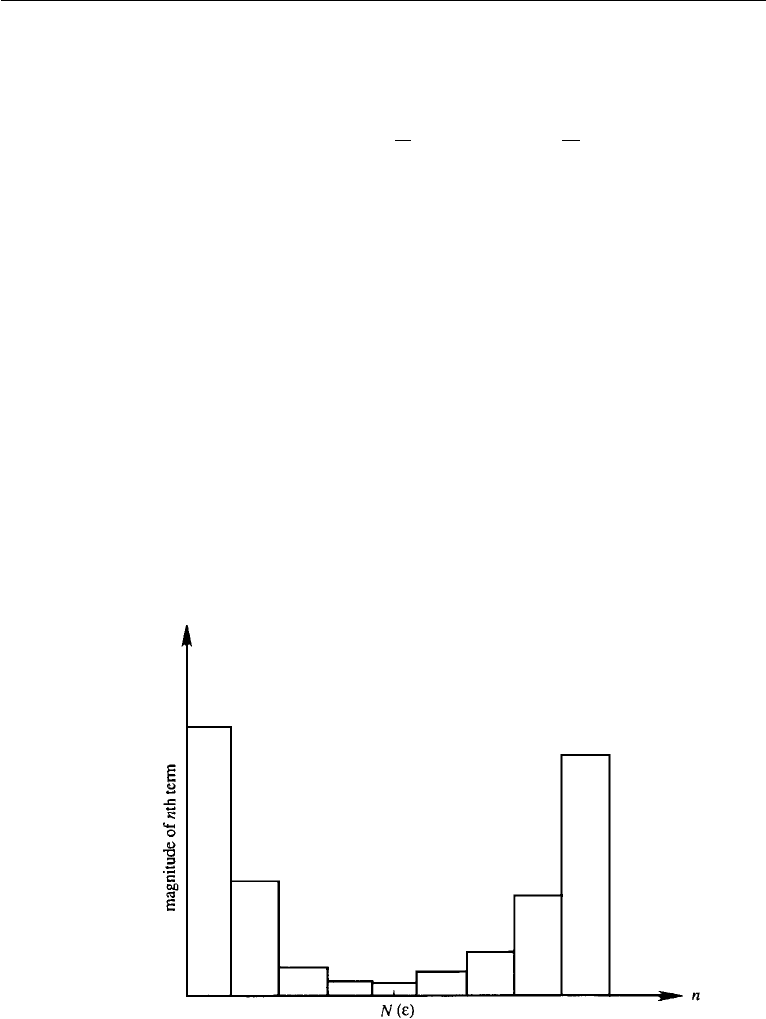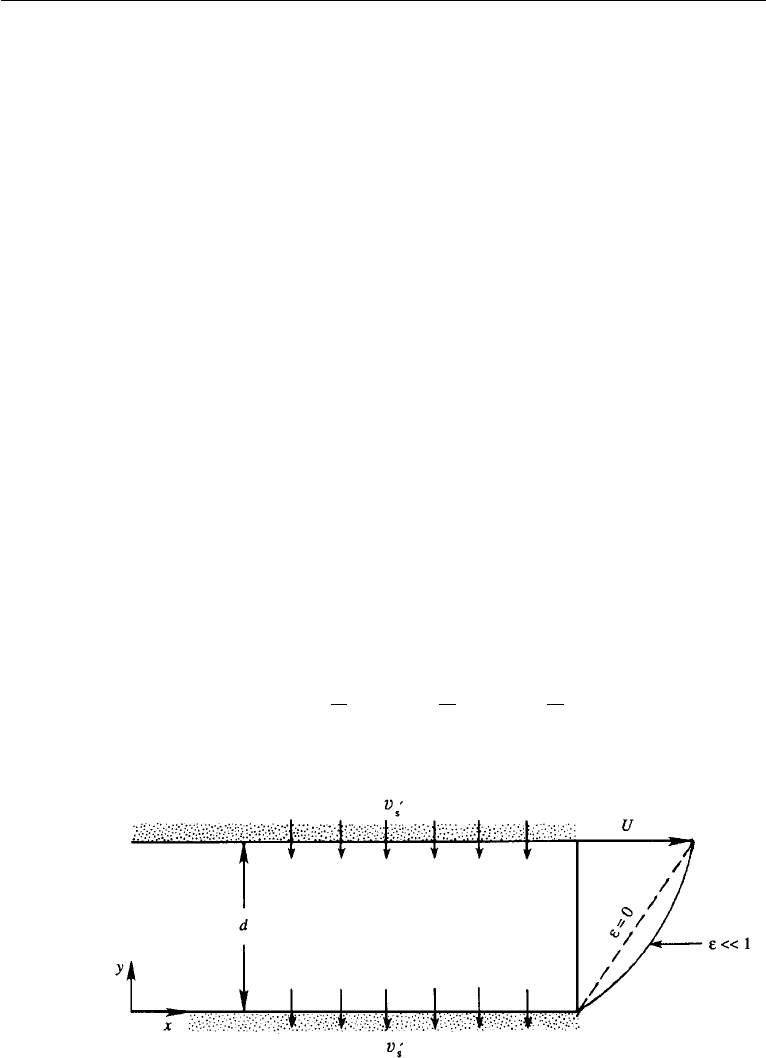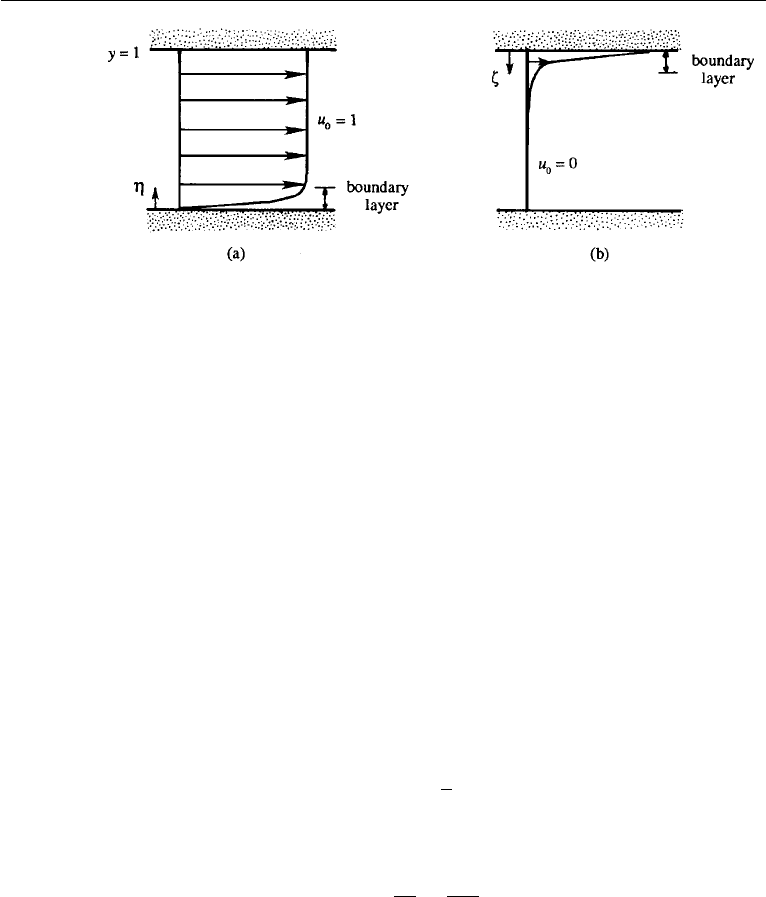Cohen I.M., Kundu P.K. Fluid Mechanics
Подождите немного. Документ загружается.


392 Boundary Layers and Related Topics
An asymptotic expansion is a finite sequence of limit statements of the type
written in the preceding. For example, because lim
ε→0
(sin ε)/ε = 1, sin ε = ε+o(ε).
Following up using the powers of ε as gauge functions,
lim
ε→0
(sin ε − ε)/ε
3
=−
1
3!
, sin ε = ε −
ε
3
3!
+ o(
3
).
By continuing this process we can establish that the term o(ε
3
) is better represented
by O(ε
5
) and is in fact
5
/5!. The series terminates with the order symbol.
The interesting property of an asymptotic expansion is that the series (10.58) may
not converge if extended indefinitely. Thus, for a fixed ε, the magnitude of a term may
eventually increase as shown in Figure 10.32. Therefore, there is an optimum number
of terms N(ε) at which the series should be truncated. The number N(ε) is difficult
to guess, but that is of little consequence, because only one or two terms in the
asymptotic expansion are calculated. The accuracy of the asymptotic representation
can be arbitrarily improved by keeping n fixed, and letting ε → 0.
We here emphasize the distinction between convergence and asymptoticity. In
convergence we are concerned with terms far out in an infinite series, a
n
. We must
have lim
n→∞
a
n
= 0 and, for example, lim
n→∞
|a
n+1
/a
n
| < 1 for convergence.
Asymptoticity is a different limit: n is fixed at a finite number and the approximation
is improved as ε (say) tends to its limit.
Figure 10.32 Terms in a divergent asymptotic series, in which N(ε) indicates the optimum number of
terms at which the series should be truncated. M. Van Dyke, Perturbation Methods in Fluid Mechanics,
1975 and reprinted with the permission of Prof. Milton Van Dyke for The Parabolic Press.

14. Perturbation Techniques 393
The value of an asymptotic expansion becomes clear if we compare the
convergent series for a Bessel function J
0
(x), given by
J
0
(x) = 1 −
x
2
2
2
+
x
4
2
2
4
2
−
x
6
2
2
4
2
6
2
+···, (10.59)
with the first term of its asymptotic expansion
J
0
(x) ∼
2
πx
cos
x −
π
4
as x →∞. (10.60)
The convergent series (10.59) is useful when x is small, but more than eight terms
are needed for three-place accuracy when x exceeds 4. In contrast, the one-term
asymptotic representation (10.60) gives three-place accuracy for x>4. Moreover,
the asymptotic expansion indicates the shape of the function, whereas the infinite
series does not.
Nonuniform Expansion
In many situations we develop an asymptotic expansion for a function of two
variables, say
f(x; ε) ∼
n
a
n
(x)g
n
(ε) as ε → 0. (10.61)
If the expansion holds for all values of x, it is called uniformly valid in x, and the prob-
lem is described as a regular perturbation problem. In this case any successive term
is smaller than the preceding term for all x. In some interesting situations, however,
the expansion may break down for certain values of x. For such values of x, a
m
(x)
increases faster with m than g
m
(ε) decreases with m, so that the term a
m
(x)g
m
(ε) is
not smaller than the preceding term. When the asymptotic expansion (10.61) breaks
down for certain values of x, it is called a nonuniform expansion, and the problem is
called a singular perturbation problem. For example, the series
1
1 + εx
= 1 −εx + ε
2
x
2
− ε
3
x
3
+···, (10.62)
is nonuniformly valid, because it breaks down when εx = O(1). No matter how small
we make ε, the second term is not a correction of the first term for x>1/ε.Wesay
that the singularity of the perturbation expansion (10.62) is at large x or at infinity.
On the other hand, the expansion
√
x + ε =
√
x
1 +
ε
x
1/2
=
√
x
1 +
ε
2x
−
ε
2
8x
2
+···
, (10.63)
is nonuniform because it breaks down when ε/x = O(1). The singularity of this
expansion is at x = 0, because it is not valid for x<ε. The regions of nonuniformity
are called boundary layers; for equation (10.62) it is x>1/ε, and for equation (10.63)

394 Boundary Layers and Related Topics
it is x<ε. To obtain expansions that are valid within these singular regions, we need
to write the solution in terms of a variable η which is of order 1 within the region
of nonuniformity. It is evident that η = εx for equation (10.62), and η = x/ε for
equation (10.63).
In many cases, singular perturbation problems are associated with the small
parameter ε multiplying the highest order derivative (as in viscous boundary layer
problems), so that the differential equation drops by one order as ε → 0, resulting in
an inability to satisfy all the boundary conditions. In several other singular perturbation
problems the small parameter does not multiply the highest-order derivative. An
example is low Reynolds number flows, for which the nondimensional governing
equation is
εu ·∇u =−∇p +∇
2
u,
where ε = Re 1. In this case the singularity or nonuniformity is at infinity. This is
discussed in Section 9.13.
15. An Example of a Regular Perturbation Problem
As a simple example of a perturbation expansion that is uniformly valid everywhere,
consider a plane Couette flow with a uniform suction across the flow (Figure 10.33).
The upper plate is moving parallel to itself at speed U and the lower plate is station-
ary. The distance between the plates is d and there is a uniform downward suction
velocity v
s
, with the fluid coming in through the upper plate and going out through the
bottom. For notational simplicity, we shall denote dimensional variables by a prime
and nondimensional variables without primes:
y =
y
d
,u=
u
U
,v=
v
U
.
Figure 10.33 Uniform suction in a Couette flow, showing the velocity profile u(y) for ε = 0 and ε 1.

15. An Example of a Regular Perturbation Problem 395
As ∂/∂x = 0 for all variables, the nondimensional equations are
∂v
∂y
= 0 (continuity), (10.64)
v
du
dy
=
1
Re
d
2
u
dy
2
(x-momentum), (10.65)
subject to
v(0) = v(1) =−v
s
, (10.66)
u(0) = 0, (10.67)
u(1) = 1, (10.68)
where Re = Ud/ν, and v
s
= v
s
/U.
The continuity equation shows that the lateral flow is independent of y and
therefore must be
v(y) =−v
s
,
to satisfy the boundary conditions on v. The x-momentum equation then becomes
d
2
u
dy
2
+ ε
du
dy
= 0, (10.69)
where ε = v
s
Re = v
s
d/ν. We assume that the suction velocity is small, so that ε 1.
The problem is to solve equation (10.69), subject to equations (10.67) and (10.68).
An exact solution can easily be found for this problem, and will be presented at the
end of this section. However, an exact solution may not exist in more complicated
problems, and we shall illustrate the perturbation approach. We try a perturbation
solution in integral powers of ε, of the form,
u(y) = u
0
(y) + εu
1
(y) + ε
2
u
2
(y) + O(ε
3
). (10.70)
(A power series in ε may not always be possible, as remarked upon in the preceding
section.) Our task is to determine u
0
(y), u
1
(y), etc.
Substituting equation (10.70) into equations (10.69), (10.67), and (10.68), we
obtain
d
2
u
0
dy
2
+ ε
du
0
dy
+
d
2
u
1
dy
2
+ ε
2
du
1
dy
+
d
2
u
2
dy
2
+ O(ε
3
) = 0, (10.71)
subject to
u
0
(0) + εu
1
(0) + ε
2
u
2
(0) + O(ε
3
) = 0, (10.72)
u
0
(1) + εu
1
(1) + ε
2
u
2
(1) + O(ε
3
) = 1. (10.73)

396 Boundary Layers and Related Topics
Equations for the various orders are obtained by taking the limits of equations
(10.71)–(10.73) as ε → 0, then dividing by ε and taking the limit ε → 0 again,
and so on. This is equivalent to equating terms with like powers of ε. Up to order ε,
this gives the following sets:
Order ε
0
:
d
2
u
0
dy
2
= 0,
u
0
(0) = 0,u
0
(1) = 1.
(10.74)
Order ε
1
:
d
2
u
1
dy
2
=−
du
0
dy
,
u
1
(0) = 0,u
1
(1) = 0.
(10.75)
The solution of the zero-order problem (10.74) is
u
0
= y. (10.76)
Substituting this into the first-order problem (10.75), we obtain the solution
u
1
=
y
2
(1 − y).
The complete solution up to order ε is then
u(y) = y +
ε
2
[y(1 −y)]+O(ε
2
). (10.77)
In this expansion the second term is less than the first term for all values of y as ε → 0.
The expansion is therefore uniformly valid for all y and the perturbation problem is
regular. A sketch of the velocity profile (10.77) is shown in Figure 10.33.
It is of interest to compare the perturbation solution (10.77) with the exact solu-
tion. The exact solution of (10.69), subject to equations (10.67) and (10.68), is easily
found to be
u(y) =
1 − e
−εy
1 − e
−ε
. (10.78)
For ε 1, Equation (10.78) can be expanded in a power series of ε, where the first
few terms are identical to those in equation (10.77).
16. An Example of a Singular Perturbation Problem
Consider again the problem of uniform suction across a plane Couette flow, discussed
in the preceding section. For the case of weak suction, namely ε = v
s
d/ν 1, we
saw that the perturbation problem is regular and the series is uniformly valid for all

16. An Example of a Singular Perturbation Problem 397
values of y. A more interesting case is that of strong suction, defined as ε 1, for
which we shall now see that the perturbation expansion breaks down near one of the
walls. As before, the v-field is uniform everywhere:
v(y) =−v
s
.
The governing equation is (10.69), which we shall now write as
δ
d
2
u
dy
2
+
du
dy
= 0, (10.79)
subject to
u(0) = 0, (10.80)
u(1) = 1, (10.81)
where we have defined
δ ≡
1
ε
=
ν
v
s
d
1,
as the small parameter. We try an expansion in powers of δ:
u(y) = u
0
(y) + δu
1
(y) + δ
2
u
2
(y) + O(δ
3
). (10.82)
Substitution into equation (10.79) leads to
du
0
dy
= 0. (10.83)
The solution of this equation is u
0
= const., which cannot satisfy conditions at both
y = 0 and y = 1. This is expected, because as δ → 0 the highest order derivative
drops out of the governing equation (10.79), and the approximate solution cannot
satisfy all the boundary conditions. This happens no matter how many terms are
included in the perturbation series. A boundary layer is therefore expected near one
of the walls, where the solution varies so rapidly that the two terms in equation (10.79)
are of the same order.
The expansion (10.82), valid outside the boundary layers, is the “outer” expan-
sion, the first term of which is governed by equation (10.83). If the outer expansion
satisfies the boundary condition (10.80), then the first term in the expansion is u
0
= 0;
if on the other hand the outer expansion satisfies the condition (10.81), then u
0
= 1.
The outer expansion should be smoothly matched to an “inner” expansion valid within
the boundary layer. The two possibilities are sketched in Figure 10.34, where it is
evident that a boundary layer occurs at the top plate if u
0
= 0, and it occurs at the
bottom plate if u
0
= 1. Physical reasons suggest that a strong suction would tend
to keep the profile of the longitudinal velocity uniform near the wall through which
the fluid enters, so that a boundary layer at the lower wall seems more reasonable.
Moreover, the ε 1 case is then a continuation of the ε 1 behavior (Figure 10.33).

398 Boundary Layers and Related Topics
Figure 10.34 Couette flow with strong suction, showing two possible locations of the boundary layer.
The one shown in (a) is the correct one.
We shall therefore proceed with this assumption and verify later in the section that it
is not mathematically possible to have a boundary layer at y = 1.
The location of the boundary layer is determined by the sign of the ratio of the
dominant terms in the boundary layer. This is the case because the boundary layer
must always decay into the domain and the decay is generally exponential. The inward
decay is required so as to match with the outer region solution. Thus a ratio of signs
that is positive (when both terms are on the same side of the equation) requires the
boundary layer to be at the left or bottom, that is, the boundary with the smaller
coordinate.
The first task is to determine the natural distance within the boundary layer, where
both terms in equation (10.79) must be of the same order. If y is a typical distance
within the boundary layer, this requires that δ/y
2
= O(1/y), that is
y = O(δ),
showing that the natural scale for measuring distances within the boundary layer is δ.
We therefore define a boundary layer coordinate
η ≡
y
δ
,
which transforms the governing equation (10.79) to
−
du
dη
=
d
2
u
dη
2
. (10.84)
As in the Blasius solution, η = O(1) within the boundary layer and η →∞far
outside of it.
The solution of equation (10.84) as η →∞is to be matched to the solution of
equation (10.79) as y → 0. Another way to solve the problem is to write a composite
expansion consisting of both the outer and the inner solutions:
u(y) =[u
0
(y) + δu
1
(y) +···]+{ˆu
0
(η) + δ ˆu
1
(η) +···}, (10.85)

16. An Example of a Singular Perturbation Problem 399
where the term within {}is regarded as the correction to the outer solution within
the boundary layer. All terms in the boundary layer correction {}go to zero as
η →∞. Substituting equation (10.85) into equation (10.79), we obtain
du
0
dy
+ δ
du
1
dy
+
d
2
u
0
dy
2
+ δ
2
+ O(δ
3
)
+ δ
−1
d ˆu
0
dη
+
d
2
ˆu
0
dη
2
+
d ˆu
1
dη
+
d
2
ˆu
1
dη
2
+ O(δ) = 0. (10.86)
A systematic procedure is to multiply equation (10.86) by powers of δ and take limits
as δ → 0, with first y held fixed and then η held fixed. When y is held fixed (which
we write as y = O(1)) and δ → 0, the boundary layer becomes progressively thinner
and we move outside and into the outer region. When η is held fixed (i.e, η = O(1))
and δ → 0, we obtain the behavior within the boundary layer.
Multiplying equation (10.86) by δ and taking the limit as δ → 0, with η = O(1),
we obtain
d ˆu
0
dη
+
d
2
ˆu
0
dη
2
= 0, (10.87)
which governs the first term of the boundary layer correction. Next, the limit of
equation (10.86) as δ → 0, with y = O(1),gives
du
0
dy
= 0, (10.88)
which governs the first term of the outer solution. (Note that in this limit η →∞,
and consequently we move outside the boundary layer where all correction terms
go to zero, that is d ˆu
1
/dη → 0 and d
2
ˆu
1
/dη
2
→ 0.) The next largest term
in equation (10.86) is obtained by considering the limit δ → 0 with η = O(1),
giving
d ˆu
1
dη
+
d
2
ˆu
1
dη
2
= 0,
and so on. It is clear that our formal limiting procedure is equivalent to setting the
coefficients of like powers of δ in equation (10.86) to zero, with the boundary layer
terms treated separately.
As the composite expansion holds everywhere, all boundary conditions can be
applied on it. With the assumed solution of equation (10.85), the boundary condition
equations (10.80) and (10.81) give
u
0
(0) +ˆu
0
(0) + δ[u
1
(0) +ˆu
1
(0)]+···=0, (10.89)
u
0
(1) + 0 + δ[u
1
(1) + 0]+···=1. (10.90)

400 Boundary Layers and Related Topics
Equating like powers of δ, we obtain the following conditions
u
0
(0) +ˆu
0
(0) = 0,u
1
(0) +ˆu
1
(0) = 0, (10.91)
u
0
(1) = 1,u
1
(1) = 0. (10.92)
We can now solve equation (10.88) along with the first condition in equation (10.92),
obtaining
u
0
(y) = 1. (10.93)
Next, we can solve equation (10.87), along with the first condition in equation (10.91),
namely
ˆu
0
(0) =−u
0
(0) =−1,
and the condition ˆu
0
(∞) = 0. The solution is
ˆu
0
(η) =−e
−η
.
To the lowest order, the composite expansion is, therefore,
u(y) = 1 − e
−η
= 1 −e
−y/δ
, (10.94)
which we have written in terms of both the inner variable η and the outer vari-
able y, because the composite expansion is valid everywhere. The first term is the
lowest-order outer solution, and the second term is the lowest-order correction in the
boundary layer.
Comparison with Exact Solution
The exact solution of the problem is (see equation (10.78)):
u(y) =
1 − e
−y/δ
1 − e
−1/δ
. (10.95)
We want to write the exact solution in powers of δ and compare with our perturbation
solution. An important result to remember is that exp (−1/δ) decays faster than any
power of δ as δ → 0, which follows from the fact that
lim
δ→0
e
−1/δ
δ
n
= lim
ε→∞
ε
n
e
ε
= 0,e
−1/δ
= o(δ
n
), n > 0,
for any n, as can be verified by applying the l’Hˆopital rule n times. Thus, the denomi-
nator in equation (10.95) exponentially approaches 1, with no contribution in powers
of δ. It follows that the expansion of the exact solution in terms of a power series in
δ is
u(y) 1 − e
−y/δ
, (10.96)

17. Decay of a Laminar Shear Layer 401
which agrees with our composite expansion (10.94). Note that no terms in powers of
δ enter in equation (10.96). Although in equation (10.94) we did not try to continue
our series to terms of order δ and higher, the form of equation (10.96) shows that these
extra terms would have turned out to be zero if we had calculated them. However, the
nonexistence of terms proportional to δ and higher is special to the current problem,
and not a frequent event.
Why There Cannot Be a Boundary Layer at y = 1
So far we have assumed that the boundary layer could occur only at y = 0. Let us
now investigate what would happen if we assumed that the boundary layer happened
to be at y = 1. In this case we define a boundary layer coordinate
ζ ≡
1 − y
δ
, (10.97)
which increases into the fluid from the upper wall (Figure 10.34b). Then the
lowest-order terms in the boundary conditions (10.91) and (10.92) are replaced by
u
0
(0) = 0,
u
0
(1) +ˆu
0
(0) = 1,
where ˆu
0
(0) represents the value of ˆu
0
at the upper wall where ζ = 0. The first
condition gives the lowest-order outer solution u
0
(y) = 0. To find the lowest-order
boundary layer correction ˆu
0
(ζ ), note that the equation governing it (obtained by
substituting equation (10.97) into equation (10.87)) is
d ˆu
0
dζ
−
d
2
ˆu
0
dζ
2
= 0, (10.98)
subject to
ˆu
0
(0) = 1 − u
0
(1) = 1,
ˆu
0
(∞) = 0.
A substitution of the form ˆu
0
(ζ ) = exp(aζ ) into equation (10.103) shows that a =
+1, so that the solution to equation (10.98) is exponentially increasing in ζ and cannot
satisfy the condition at ζ =∞.
17. Decay of a Laminar Shear Layer
It is shown in Chapter 12 (pp. 515–516) that flows exhibiting an inflection point
in the streamwise velocity profile are highly unstable. These results, based on the
Orr-Sommerfeld analysis for parallel flows, have been re-examined recently and it has
been found that the instability is not manifested until sufficiently far downstream for
similarity to develop. This is discussed in more detail in Chapter 12. Here we note that
